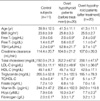1. Mc Demott MT, Ridgeway EC. Subclinical hypothyroidism is mild thyroid failure and should be treated. J Clin Endocrinol Metab. 2001. 86:4585–4590.
2. Canalis GJ, Manowitz NR, Mayor G, Ridgeay EC. The Colorado thyroid disease prevalence study. Arch Intern Med. 2000. 160:526–534.

3. Cantürk Z, Çetinarslan B, Tarkun l, Cantürk NZ, Özden M, Duman C. Hemostatic system as a risk factor for cardiovascular disease in women in subclinical hypothyroidism. Thyroid. 2003. 13:971–977.
4. Hak AE, Pols HA, Visser TJ, Drexhage HA, Hofman A, Witteman JC. Subclinical hypothyroidism is an independent risk factor for atherosclerosis and myocardial infarction in elderly women: The Rotterdam Study. Ann Intern Med. 2000. 132:270–278.

5. Lien EA, Nedrebo BG, Varhaug JE, Nygard O, Aakvaag A, Ueland PM. Plasma total homocysteine levels during short term iatrogenic hypothyroidism. J Clin Endocrinol Metab. 2000. 85:1049–1053.
6. Nedrebo BG, Nygard O, Ueland PM, Lien EA. Plasma total homocysteine in hyper- and hypothyroid patients before and during 12 months of treatment. Clin Chem. 2001. 47:1738–1741.
7. Chadarevian R, Bruckert E, Leenhardt L, Giral P, Ankri A, Turpin G. Components of the fibrinolytic system are differently altered in moderate and severe hypothyroidism. J Clin Endocrinol Metab. 2001. 86:732–737.

8. Chadarevian R, Bruckert E, Giral P, Turpin G. Relationship between thyroid hormones and fibrinogen levels. Blood Coagul Fibrinolysis. 1999. 10:481–486.

9. Myrup B, Bregengard C, Faber JF. Primary haemostasis in thyroid disease. J Intern Med. 1995. 238:59–63.

10. Nedrebo B, Ericsson UB, Ueland PM, Refsum H, Lien EA. Plasma levels of the atherogenic aminoacid homocysteine in hyper- and hypothyroid patients. Eur J Endocrinol. 1994. 130:147.
11. Diekman MJ, Van der Put NM, Blom HJ, Tijssen JG, Wiersinga WM. Determinants of changes in plasma homocysteine in hyperthyroidism and hypothyroidism. Clin Endocrinol. 2001. 54:197–204.

12. Nedrebo BG, Ericsson UB, Nygard O, Refsum H, Ueland PM, Aakvaag A. Plasma total homocysteine levels in hyperthyroid and hypothyroid patients. Metabolism. 1998. 47:89–93.

13. Hussein WI, Green R, Jacobsen DW, Faiman C. Normalization of hyperhomocysteinemia with L-thyroxine in hypothyroidism. Ann Intern Med. 1999. 131:348–351.
14. Barbe F, Klein M, Chango A, Fremont S, Gerard P, Weryha G, Gueant JL, Nicolas JP. Homocysteine, folate, vitamin B12, and transcobalamins in patients undergoing successive hypo-and euthyroid states. J Clin Endocrinol Metab. 2001. 86:1845–1846.
15. Morris MS, Bostom AG, Jacques PF, Selhub J, Rosenberg IH. Hyperhomocysteinemia and hypercholesterolemia associated with hypothyroidism in the third US National Health and Nutrition Examination Survey. Atherosclerosis. 2001. 155:195–200.

16. Homocysteine Lowering Trialists. Collaboration lowering blood homocysteine with folic acid based supplements: meta-analysis of randomized trials. BMJ. 1998. 316:894–898.
17. Selhub J, Jacques PF, Wilson PWF, Rush D, Rosenberg IH. Vitamin status and intake as primary determinants of homocysteinemia in an elderly population. JAMA. 1993. 270:2693–2698.

18. Lindeman RD, Romero LJ, Schade DS, Wayne S, Baumgarter RN, Garry PJ. Impact of subclinical hypothyroidism on serum total homocysteine concentrations, the prevalence of coronary heart disease (CHD), and CHD risk factors in the New Mexico elder healt survey. Thyroid. 2003. 13:595–600.
19. Luboshitzky R, Aviv A, Herer P, Lavie L. Risk factors for cardiovascular disease in women with subclinical hypothyroidism. Thyroid. 2002. 12:421–425.

20. Atabek ME, Pirgon O, Erkul I. Plasma homocysteine concentrations in adolescents with subclinical hypothyroidism. J Pediatr Endocrinol Metab. 2003. 16:1245–1248.

21. Deicher R, Vierhapper H. Homocysteine: a risk factor for cardiovascular disease in subclinical hypothyroidism? Thyroid. 2002. 12:733–736.

22. Sengul E, Cetinarslan B, Tarkun I, Canturk Z, Turemen E. Homocysteine concentrations in subclinical hypothyroidism. Endocr Res. 2004. 30:351–359.
23. Perez E, Cubero JM, Sucunza N, Ortega E, Arcelus R, Espinosa JR, Lianos OJ, Vaca FB. Emerging cardiovascular risk factors in subclinically hypothyroidism: Lack of change after restoration of euthyroidis. Metab. 2004. 53:1512–1515.
24. Ozcan O, Cakir E, Yaman H, Akgul EO, Erturtk K, Beyhan Z, Bilgi C, Erbil MK. The effects of thyroxine replacement on the levels of serum asymmetric dimethylarginine (ADMA) and other biochemical cardiovascular risk markers in patients with subclinical hypothyroidism. Clin Endocrinol. 2005. 63:203–206.

25. Lowe GD, Wood DA, Douglas JT, Riemersma RA, Macintyra CC, Takase T, Tuddenham EG, Forbes CD, Elton RA, Oliver MF. Relationships of plasma viscosity, coagulation and fibrinolysis to coronary risk factors and angina. Thromb Haemost. 1991. 65:339–343.

26. Thomson WD, Smith EB. Atherosclerosis and coagulation system. J Pathol. 1989. 159:97–106.
27. Folsom AR. Epidemiology of fibrinogen. Eur Heart J. 1995. 16:Suppl A. 21–23.

28. Müller B, Tsakiris DA, Roth CB, Guglielmetti M, Staub JJ, Marbet GA. Haemostatic profile in hypothyroidism as potential risk factor for vascular or thrombotic disease. Eur J Clin Invest. 2001. 31:131–137.

29. Diekman MJ, Anghelescu N, Endert E, Bakker O, Wiersinga WM. Changes in plasma low density lipoprotein and high density lipoprotein cholesterol in hypo and hyperthyroid patients are related to changes in free thyroxin, not to polymorphisms in LDL receptor or cholesterol ester transfer protein genes. J Clin Endocrinol Metab. 2000. 85:1857–1863.
30. Bauer DC, Ettinger B, Browner WS. Thyroid function and serum lipids in older women: a population based study. Am J Med. 1998. 104:546–551.
31. Arem R, Patsch W. Liporotein and apolipoprotein levels in subclinical hypothyroidism. Effects of levothyroxine therapy. Arch Intern Med. 1990. 150:2097–2100.
32. Caron P, Calazel C, Parra HJ, Hoff M, Louvet JP. Decreased HDL cholesterol in subclinical hypothyroidism : the effect of levothyroxine therapy. Clin Endocrinol. 1990. 33:519–523.
33. Meier C, Staub JJ, Roth CB, Guglielmetti M, Kunz M, Miserez AR, Drewe J, Huber P, Herzog R, Muller B. TSH-controlled L-thyroxine therapy reduces cholesterol levels and clinical symptoms in subclinical hypothyroidism: A double blind, placebo controlled trial (basel thyroid study). J Clin Endocrinol Metab. 2001. 86:4860–4868.
34. Serter R, Demirbas B, Korukluoglu B, Culha C, Cakal E, Aral Y. The effect of L-Thyroxine replacement therapy on lipid based cardiovascular risk in subclinical hypothyroidism. J Endocrinol Invest. 2004. 27:897–903.







 PDF
PDF ePub
ePub Citation
Citation Print
Print


 XML Download
XML Download